最新高中英语必修三知识点外研版
- 格式:doc
- 大小:72.50 KB
- 文档页数:16
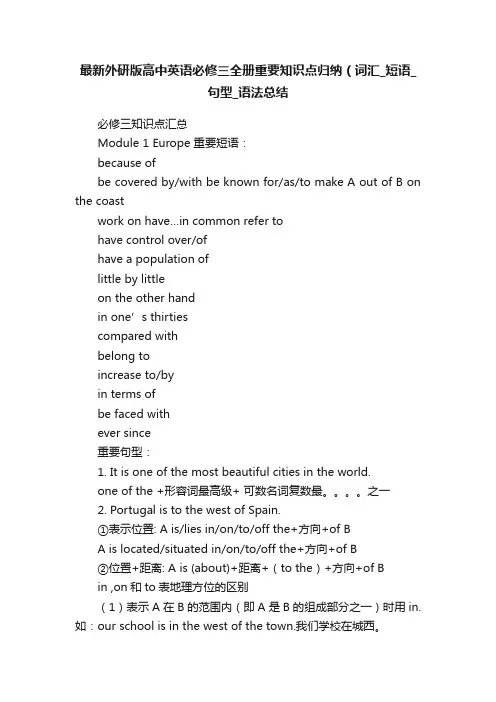
最新外研版高中英语必修三全册重要知识点归纳(词汇_短语_句型_语法总结必修三知识点汇总Module 1 Europe 重要短语:because ofbe covered by/with be known for/as/to make A out of B on the coastwork on have…in common refer tohave control over/ofhave a population oflittle by littleon the other handin one’s thirtiescompared withbelong toincrease to/byin terms ofbe faced withever since重要句型:1. It is one of the most beautiful cities in the world.one of the +形容词最高级+ 可数名词复数最。
之一2. Portugal is to the west of Spain.①表示位置: A is/lies in/on/to/off the+方向+of BA is located/situated in/on/to/off the+方向+of B②位置+距离: A is (about)+距离+(to the)+方向+of Bin ,on和to表地理方位的区别(1)表示A在B的范围内(即A是B的组成部分之一)时用in.如:our school is in the west of the town.我们学校在城西。
(2)强调A和B两地接壤时,用on.如:Korea is on the east of China.朝鲜与中国东部接壤。
(3)A在B的范围之外,两者之间没有所属关系时用to。
如:Our school is to the west of the hospital.我们学校在医院的西面。
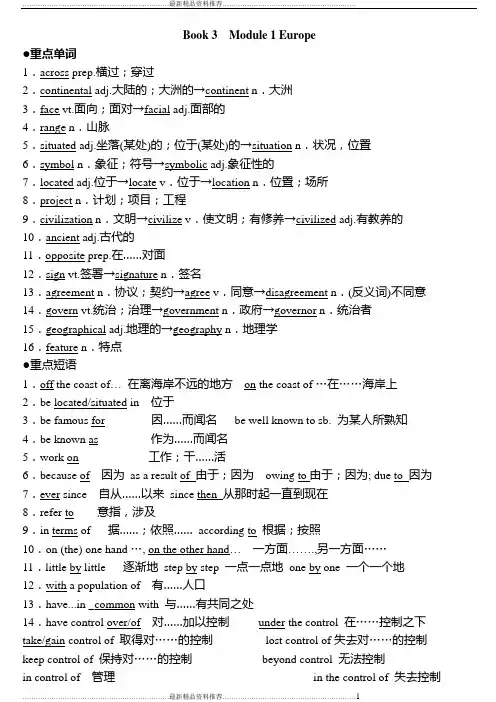
Book 3 Module 1 Europe●重点单词1.across prep.横过;穿过2.continental adj.大陆的;大洲的→continent n.大洲3.face vt.面向;面对→facial adj.面部的4.range n.山脉5.situated adj.坐落(某处)的;位于(某处)的→situation n.状况,位置6.symbol n.象征;符号→symbolic adj.象征性的7.located adj.位于→locate v.位于→location n.位置;场所8.project n.计划;项目;工程9.civilization n.文明→civilize v.使文明;有修养→civilized adj.有教养的10.ancient adj.古代的11.opposite prep.在……对面12.sign vt.签署→signature n.签名13.agreement n.协议;契约→agree v.同意→disagreement n.(反义词)不同意14.govern vt.统治;治理→government n.政府→governor n.统治者15.geographical adj.地理的→geography n.地理学16.feature n.特点●重点短语1.off the coast of…在离海岸不远的地方on the coast of …在……海岸上2.be located/situated in 位于3.be famous for 因……而闻名be well known to sb. 为某人所熟知4.be known as 作为……而闻名5.work on 工作;干……活6.because of 因为as a result of 由于;因为owing to由于;因为; due to 因为7.ever since 自从……以来since then 从那时起一直到现在8.refer to 意指,涉及9.in terms of 据……;依照……according to 根据;按照10.on (the) one hand …, on the other hand…一方面…….,另一方面……11.little by little 逐渐地step by step 一点一点地one by one 一个一个地12.with a population of 有……人口13.have...in _common with 与……有共同之处14.have control over/of 对……加以控制under the control 在……控制之下take/gain control of 取得对……的控制lost control of失去对……的控制keep control of 保持对……的控制beyond control 无法控制in control of 管理in the control of 失去控制15. of all time有史以来all the time 一直;始终at times 有时;偶尔at one time 一度;曾经16. in common 共同in common with和……相同common practice 惯例common sense 常识17. compare with/to…与……相比较compare notes 交换意见by comparison 相比之下in comparison with/to…与……相比Word study:1. range n. 排;连续;山脉;(变化等的)幅度;(知识等的)范围;区域;射程v. 排列,使排队;(动植物)分布;(在一定范围内)变化,变动Between France and Spain is another mountain range – the Pyrenees.a wide range of 广泛的…;各种各样的a full range of 各种……within/in range of在……的范围内beyond/out of one‘s range超越了……的范围range from...to...在……范围内变动,包括(由……到……)之间的各类事物range between...and... 在……和……范围内变动range over 范围涉及range…in rows 把……排成队eg. (1)The child was now out of her range of vision.这孩子已经走出了她的视线。
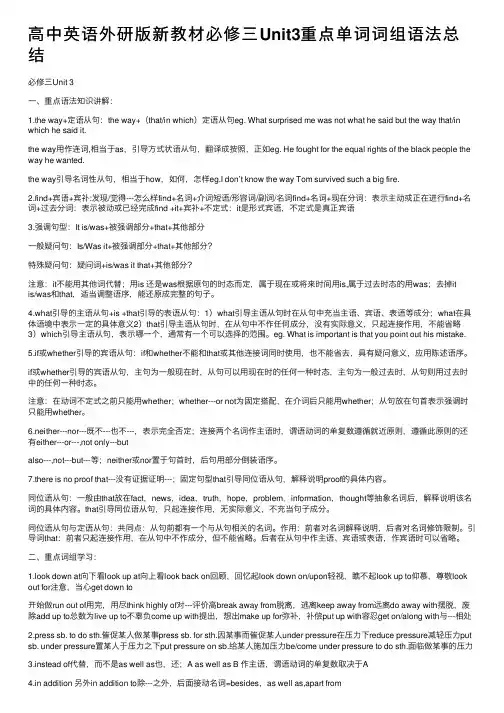
⾼中英语外研版新教材必修三Unit3重点单词词组语法总结必修三Unit 3⼀、重点语法知识讲解:1.the way+定语从句:the way+(that/in which)定语从句eg. What surprised me was not what he said but the way that/in which he said it.the way⽤作连词,相当于as,引导⽅式状语从句,翻译成按照,正如eg. He fought for the equal rights of the black people the way he wanted.the way引导名词性从句,相当于how,如何,怎样eg.I don’t know the way Tom survived such a big fire.2.find+宾语+宾补:发现/觉得---怎么样find+名词+介词短语/形容词/副词/名词find+名词+现在分词:表⽰主动或正在进⾏find+名词+过去分词:表⽰被动或已经完成find +it+宾补+不定式:it是形式宾语,不定式是真正宾语3.强调句型:It is/was+被强调部分+that+其他部分⼀般疑问句:Is/Was it+被强调部分+that+其他部分?特殊疑问句:疑问词+is/was it that+其他部分?注意:it不能⽤其他词代替;⽤is 还是was根据原句的时态⽽定,属于现在或将来时间⽤is,属于过去时态的⽤was;去掉itis/was和that,适当调整语序,能还原成完整的句⼦。
4.what引导的主语从句+is +that引导的表语从句:1)what引导主语从句时在从句中充当主语、宾语、表语等成分;what在具体语境中表⽰⼀定的具体意义2)that引导主语从句时,在从句中不作任何成分,没有实际意义,只起连接作⽤,不能省略3)which引导主语从句,表⽰哪⼀个,通常有⼀个可以选择的范围。
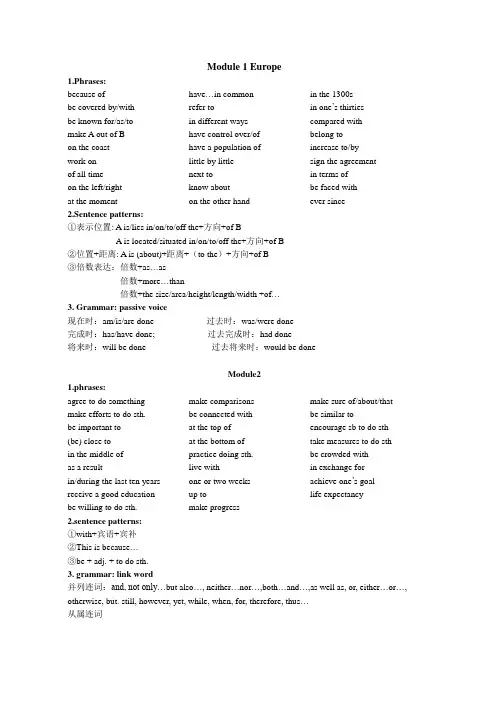
Module 1 Europe 1.Phrases:because ofbe covered by/with be known for/as/to make A out of B on the coastwork onof all timeon the left/rightat the moment have…in commonrefer toin different wayshave control over/ofhave a population oflittle by littlenext toknow abouton the other handin the 1300sin one’s thirtiescompared withbelong toincrease to/bysign the agreementin terms ofbe faced withever since2.Sentence patterns:①表示位置: A is/lies in/on/to/off the+方向+of BA is located/situated in/on/to/off the+方向+of B②位置+距离: A is (about)+距离+(to the)+方向+of B③倍数表达:倍数+as…as倍数+more…than倍数+the size/area/height/length/width +of…3. Grammar: passive voice现在时:am/is/are done 过去时:was/were done完成时:has/have done; 过去完成时:had done将来时:will be done 过去将来时:would be doneModule21.phrases:agree to do something make efforts to do sth.be important to(be) close toin the middle ofas a resultin/during the last ten years receive a good education be willing to do sth. make comparisonsbe connected withat the top ofat the bottom ofpractice doing sth.live withone or two weeksup tomake progressmake sure of/about/thatbe similar toencourage sb to do sthtake measures to do sthbe crowded within exchange forachieve one’s goallife expectancy2.sentence patterns:①with+宾语+宾补②This is because…③be + adj. + to do sth.3. grammar: link word并列连词:and, not only…but also…, neither…nor…,both…and…,as well as, or, either…or…, otherwise, but. still, however, yet, while, when, for, therefore, thus…从属连词Module3 1.phrases:a column of air pick upat seaput down take offon average natural disaster catch fire pour downset fire tomanage to do sth.put outreport onfall downfrom side to sidein allend up in/withturn overlose one’s lifeaccording totake placea total ofit occur to sb that2.sentence patterns:①By the time…did…, sb. had done sth.By the time…do/does…, sb. will have done sth.②There was the possibility of…It is possible that…3.Grammar: indirect speech(人称,时态,代词,时间和地点状语)Module 4 1.Phrasescut downdig upbe caught in …walk up to plan to doin a week’s time sweep away take ingive outI have no ideahave an effect on …one after anotherlook throughbe part of …do one’s bestin a nutshellsolve problembe / feel concerned about /for …think seriously about …prevent/stop…(from)doing solve problem2.sentence patterns①a dj. + enough to do②do nothing but do sth③can’t (help) but do sth.④I couldn’t agree withyou more / it couldn’t be worse⑤if possible3.Grammar: to do 不定式一般式:to do/to be done进行式:to be doing完成式:to have done /to have been done主和ing 区别宾表主语内容/ 计划/ 义务定序数词/ 最高级/ 逻辑关系状目的:in order to /so as to / 原因:喜怒哀乐词后/ 结果:adj. enough to do \ too … to …\ only to …补:五看三使两听一感觉Module 5 1.phrases:be kind tobe related tobe equal to human being be born + adj. /n tell the time bring upbe at war with live a (n) … lifefollow / take one’s advicea sense of responsibilityfor the first timein conclusionmake contribution to …be proud of…if sobe similar toas a resultin some waysstress the importance of…be influenced by…be similar to … /in …2.Sentence patternsThe reason why … is that…If …,then …Not only … ,but also …No more … than3.GrammarAttributive clauseModule 6 1.Phrasesprovide sth. for sb. /sb. with sth.date from /back to …hold backwork outcome trueglobal warmingbe equal toused to make senseof all timedream ofthink ofhear fromnow that ..live a (n.) … lifemake a note /notesbring an end to …a large amount of …on the spotwork outbe on a visit to …be pleased within factcrash intounder construction2.Sentence patternsIt takes sb. Time to do sth.be of + n. = be + adj.by doing sth.3.GrammarNon – defining attributive clauses。
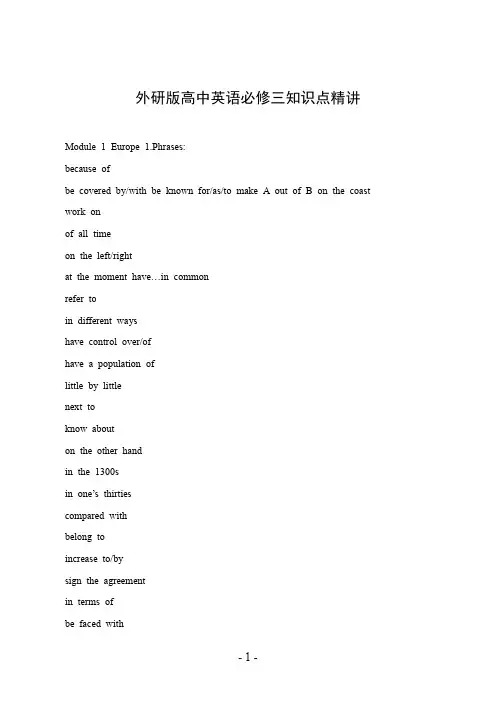
外研版高中英语必修三知识点精讲Module 1 Europe 1.Phrases:because ofbe covered by/with be known for/as/to make A out of B on the coast work onof all timeon the left/rightat the moment have…in commonrefer toin different wayshave control over/ofhave a population oflittle by littlenext toknow abouton the other handin the 1300sin one’s thirtiescompared withbelong toincrease to/bysign the agreementin terms ofbe faced withever since2.Sentence patterns:①表示位置:A is/lies in/on/to/off the+方向+of BA is located/situated in/on/to/off the+方向+of B②位置+距离:A is(about+距离+(to the+方向+of B③倍数表达:倍数+as…as倍数+more…than倍数+the size/area/height/length/width+of…3.Grammar:passive voice现在时:am/is/are done过去时:was/were done完成时:has/have done;过去完成时:had done将来时:will be done过去将来时:would be doneModule21.phrases:agree to do something make efforts to do sth.be important to(be close toin the middle ofas a resultin/during the last ten years receive a good education be willing to do sth.make compari sonsbe connected withat the top ofat the bottom ofpractice doing sth.live withone or two weeksup tomake progressmake sure of/about/thatbe similar toencourage sb to do sthtake measures to do sthbe crowded within exchange forachieve one’s goallife expectancy2.sentence patterns:①with+宾语+宾补②This is because…③be+adj.+to do sth.3.grammar:link word并列连词:and,not only…but also…,neither…nor…,both…and…,as well as,or,either…or…,o therwise,but.still,however,yet,while,when,for,therefore,thus…从属连词Module3 1.phrases:a column of air pick upat seaput down take offon average natural disaster catch fire pour downset fire tomanage to do sth.put outreport onfall downfrom side to sidein allend up in/withturn overlose one’s lifeaccording totake placea total ofit occur to sb that2.sentence patterns:①By the time…did…,sb.had done sth.By the time…do/does…,sb.will have done sth.②There was the possibility of…It is possible that…3.Grammar:indirect speech(人称,时态,代词,时间和地点状语Module 4 1.Phrasescut downdig upbe caught in…walk up to plan to doin a week’s time sweep away take ingive outI have no ideahave an effect on…one after anotherlook throughdo one’s bestin a nutshellsolve problembe/feel concerned about/for…think seriously about…prevent/st op…(fromdoing solve problem2.sentence patterns①a dj.+enough to do②do nothing but do sth③can’t(help but do sth.④I couldn’t agree withyou more/it couldn’t be worse⑤if possible3.Grammar:to do不定式一般式:to do/to be done进行式:to be doing完成式:to have done/to have been done主和ing区别宾表主语内容/计划/义务定序数词/最高级/逻辑关系状目的:in order to/so as to/原因:喜怒哀乐词后/结果:adj.enough to do\too…to…\only to…补:五看三使两听一感觉Module 5 1.phrases:be kind tobe equal to human being be born+adj./n tell the time bring up be at war with live a(n…li fefollow/take one’s advicea sense of responsibilityfor the first timein conclusionmake contribution to…be proud of…if sobe similar toas a resultin some waysstress the importance of…be influenced by…be similar to…/in…2.Sentence patternsThe re ason why…is that…If…,then…Not only…,but also…No more…than3.GrammarAttributive clauseModule 6 1.Phrasesprovide sth.for sb./sb.with sth.date from/back to…hold backwork outcome trueglobal warmingbe equal toused to make senseof all timedream ofthink ofhear fromnow that..live a(n.…lifemake a note/notesbring an end to…a large amount of…on the spotwork outbe on a visit to…be pleased within factcrash intounder construction2.Sentence patternsIt takes sb.Time to do sth.be of+n.=be+adj.by doing sth.3.GrammarNon–defining attributive clauses。
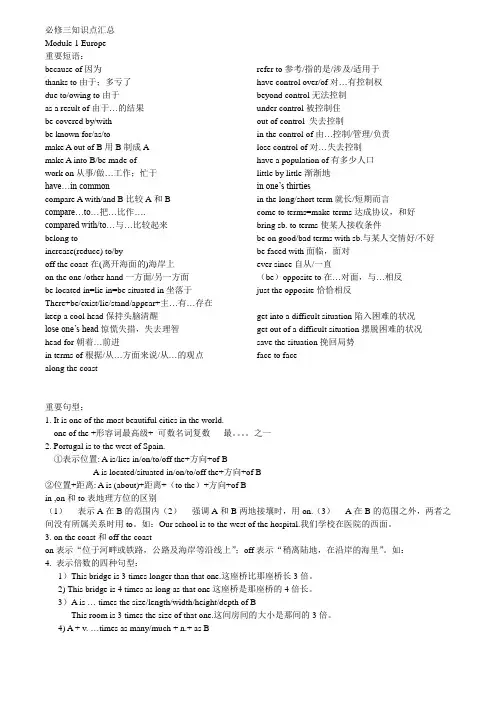
必修三知识点汇总Module 1 Europe 重要短语:because of因为thanks to由于;多亏了due to/owing to由于as a result of由于…的结果be covered by/withbe known for/as/tomake A out of B用B制成A make A into B/be made of work on从事/做…工作;忙于have…in common refer to参考/指的是/涉及/适用于have control over/of对…有控制权beyond control无法控制under control被控制住out of control 失去控制in the control of由…控制/管理/负责lose control of对…失去控制have a population of有多少人口little by little渐渐地in one’s thirtiescompare A with/and B比较A和B compare…to…把…比作…. compared with/to…与…比较起来belong toincrease(reduce) to/by in the long/short term就长/短期而言come to terms=make terms达成协议,和好bring sb. to terms使某人接收条件be on good/bad terms with sb.与某人交情好/不好be faced with面临,面对off the coast在(离开海面的)海岸上ever since自从/一直on the one /other hand一方面/另一方面be located in=lie in=be situated in坐落于There+be/exist/lie/stand/appear+主…有…存在(be)opposite to在…对面,与…相反just the opposite恰恰相反keep a cool head保持头脑清醒lose one’s head惊慌失措,失去理智head for朝着…前进get into a difficult situation陷入困难的状况get out of a difficult situation摆脱困难的状况save the situation挽回局势in terms of根据/从…方面来说/从…的观点face to facealong the coast重要句型:1. It is one of the most beautiful cities in the world.one of the +形容词最高级+ 可数名词复数最。
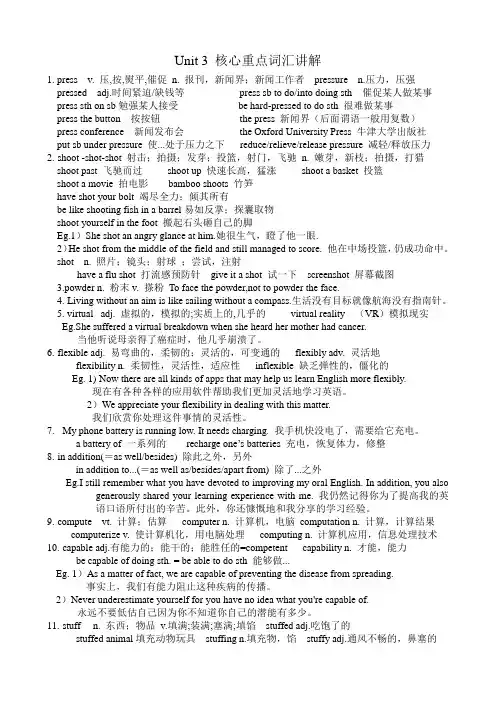
Unit 3 核心重点词汇讲解1. press v. 压,按,熨平,催促n. 报刊,新闻界;新闻工作者pressure n.压力,压强pressed adj.时间紧迫/缺钱等press sb to do/into doing sth 催促某人做某事press sth on sb勉强某人接受be hard-pressed to do sth 很难做某事press the button 按按钮the press 新闻界(后面谓语一般用复数)press conference 新闻发布会the Oxford University Press 牛津大学出版社put sb under pressure 使...处于压力之下reduce/relieve/release pressure 减轻/释放压力2.shoot -shot-shot 射击;拍摄;发芽;投篮,射门,飞驰n. 嫩芽,新枝;拍摄,打猎shoot past 飞驰而过shoot up 快速长高,猛涨shoot a basket 投篮shoot a movie 拍电影bamboo shoots 竹笋have shot your bolt 竭尽全力;倾其所有be like shooting fish in a barrel易如反掌;探囊取物shoot yourself in the foot 搬起石头砸自己的脚Eg.1)She shot an angry glance at him.她很生气,瞪了他一眼.2)He shot from the middle of the field and still managed to score. 他在中场投篮,仍成功命中。
shot n. 照片;镜头;射球;尝试,注射have a flu shot 打流感预防针give it a shot 试一下screenshot 屏幕截图3.powder n. 粉末v. 搽粉To face the powder,not to powder the face.4. Living without an aim is like sailing without a compass.生活没有目标就像航海没有指南针。
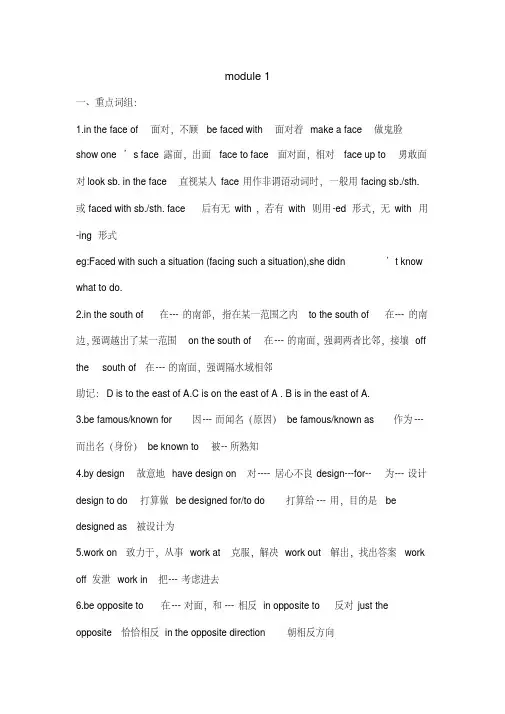
module 1一、重点词组:1.in the face of面对,不顾be faced with面对着make a face 做鬼脸show one’s face露面,出面face to face面对面,相对face up to 勇敢面对look sb. in the face直视某人face用作非谓语动词时,一般用facing sb./sth.或faced with sb./sth. face后有无with,若有with则用-ed形式,无with用-ing形式eg:Faced with such a situation (facing such a situation),she didn’t know what to do.2.in the south of 在---的南部,指在某一范围之内to the south of 在---的南边,强调越出了某一范围on the south of在---的南面,强调两者比邻,接壤off the south of在---的南面,强调隔水域相邻助记:D is to the east of A.C is on the east of A . B is in the east of A.3.be famous/known for因---而闻名(原因)be famous/known as 作为---而出名(身份)be known to被--所熟知4.by design 故意地have design on对----居心不良design---for--为---设计design to do打算做be designed for/to do打算给---用,目的是be designed as被设计为5.work on致力于,从事work at 克服,解决work out解出,找出答案work off发泄work in 把---考虑进去6.be opposite to 在---对面,和---相反in opposite to反对just the opposite恰恰相反in the opposite direction朝相反方向7.hand in交上,交付hand on把---传下去hand out分发out of hand无法控制at hand 在附近by hand用手工,用体力in hand在进行中,待办理hand in hand手拉手,密切关联的e across偶然遇到get across通过,使被理解across the country遍布全国9.a wide range of大范围的within range of---在---范围内rangefrom---to---在---和---之间变化10.in terms of就---而言,依照---in the long/short term就长期/短期而言be on good/bad terms with sb.与某人关系好/不好come to terms with妥协,达成协议on one’s terms依照某人的条件11. more---than---与其说---倒不如说no more than 仅仅,不过,只是not more than至多,不超过other than 不同于,除了rather than 胜于,而不是or rather更确切地说,倒不如说more than+数次表示多于,超过;+动名词表示不只是,不仅仅是;+形容词、副词表示非常,十分;more than和含有情态动词的句子或抽象名词如imagination/description连用有否定意义,表示难以或超过了----所能eg. The beauty of the mountainous village is more than I can describe.12.be situated on/in/at位于---,坐落在---,be badly/well situated处境糟糕/良好in a ---situation处于---状态be located in/lie in坐落于,位于13.sign to sb. to do sth.打手势让某人做某事sign in/out签到/签退sign up报名 a sign of------的标志/迹象make/give a sign to对---做手势二、单词:1.across:横过,穿过through:通过,穿过over:跨过,越过,指从上方跨越而过past:经过,指从某物旁边经过2.discover指发现某种本来存在而以前未被发现的事物,uncover表示揭露,暴露一般用于贬义3.symbol象征,符号sign记号,标记signal信号mark斑点,记号,标志4.range山脉,范围,变化,排列,分类represent代表civilisation文明ancient 古代的region地区三、语法:1.20 percent of/part of/half of/2/3 of+可数名词复数+复数谓语动词(不可数名词+单数谓语动词)2.because of因为,由于+名词、代词、动名词because后跟一个完整的句子,引导原因状从owing to由于,因为用作状语,可置于句首或句末as a result of 作为---的结果thanks to多亏,依靠既可用于正面意思,也可用于讽刺due to 由于,归因于3.ever since自---以来与完成时连用since then 从那时以来,与现在完成时连用from then on从那时起,与过去时连用,指从过去某一时刻连用ever before 以往任何时候常出现在than后面after that表示在过去某一件事以后,要用过去式4.没有被动形式的短语:belong to,take place,come about,come out,comeup,come true,break out,run out,date from,date back to,consist of这些词语的非谓语动词形式一般只有-ing形式被动语态口诀:谁做的动作不知道,说出谁的没必要;突出承受者或礼貌,用被动语态错不了。
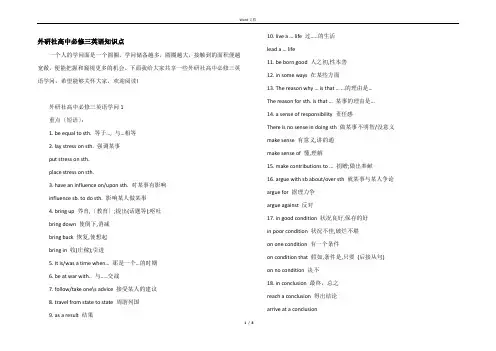
外研社高中必修三英语知识点一个人的学问面是一个圆圈,学问储备越多,圆圈越大,接触到的面积便越宽敞,便能把握和窥视更多的机会。
下面我给大家共享一些外研社高中必修三英语学问,希望能够关怀大家,欢迎阅读!外研社高中必修三英语学问1重点〔短语〕:1. be equal to sth. 等于…, 与…相等2. lay stress on sth. 强调某事put stress on sth.place stress on sth.3. have an influence on/upon sth. 对某事有影响influence sb. to do sth. 影响某人做某事4. bring up 养育,〔教育〕;提出(话题等);呕吐bring down 使倒下,消减bring back 恢复,使想起bring in 收(庄稼);引进5. It is/was a time when… 那是一个…的时期6. be at war with.. 与…..交战7. follow/take one\s advice 接受某人的建议8. travel from state to state 周游列国9. as a result 结果10. live a … life 过…..的生活lead a … life11. be born good 人之初,性本善12. in some ways 在某些方面13. The reason why … is that … …的理由是…The reason for sth. is that … 某事的理由是…14. a sense of responsibility 责任感There is no sense in doing sth 做某事不明智/没意义make sense 有意义,讲的通make sense of 懂,理解15. make contributions to … 捐赠;做出奉献16. argue with sb about/over sth 就某事与某人争论argue for 据理力争argue against 反对17. in good condition 状况良好,保存的好in poor condition 状况不佳,破烂不堪on one condition 有一个条件on condition that 假如,条件是,只要(后接从句)on no condition 决不18. in conclusion 最终,总之reach a conclusion 得出结论arrive at a conclusiondraw a conclusioncome to conclusion19. for the first time 第一次,首次no faster than 和…一样不快= as slowly as语法要求:一:限制性定语从句:用来修饰某个名词或代词的从句,叫定语从句。
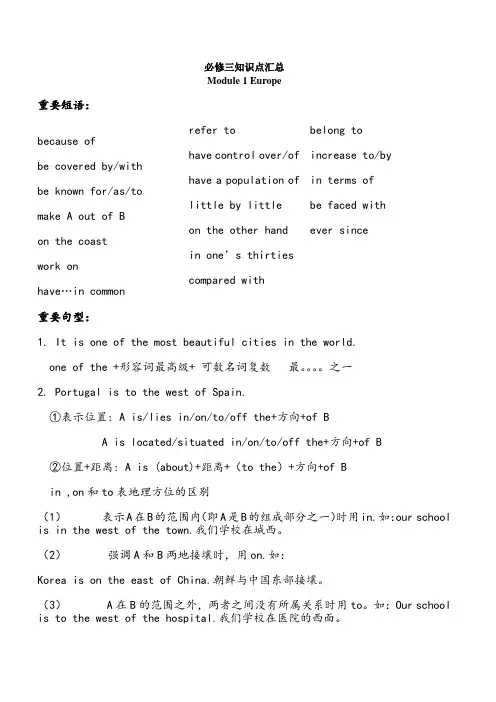
必修三知识点汇总Module 1 Europe 重要短语:because ofbe covered by/with be known for/as/to make A out of Bon the coastwork onhave…in common refer tohave control over/ofhave a population oflittle by littleon the other handin one’s thirties compared withbelong toincrease to/byin terms ofbe faced withever since重要句型:1. It is one of the most beautiful cities in the world.one of the +形容词最高级+ 可数名词复数最。
之一2. Portugal is to the west of Spain.①表示位置: A is/lies in/on/to/off the+方向+of BA is located/situated in/on/to/off the+方向+of B②位置+距离: A is (about)+距离+(to the)+方向+of Bin ,on和to表地理方位的区别(1)表示A在B的范围内(即A是B的组成部分之一)时用in.如:our school is in the west of the town.我们学校在城西。
(2)强调A和B两地接壤时,用on.如:Korea is on the east of China.朝鲜与中国东部接壤。
(3) A在B的范围之外,两者之间没有所属关系时用to。
如:Our school is to the west of the hospital.我们学校在医院的西面。
3. on the coast和off the coaston表示“位于河畔或铁路,公路及海岸等沿线上”;off表示“稍离陆地,在沿岸的海里”。
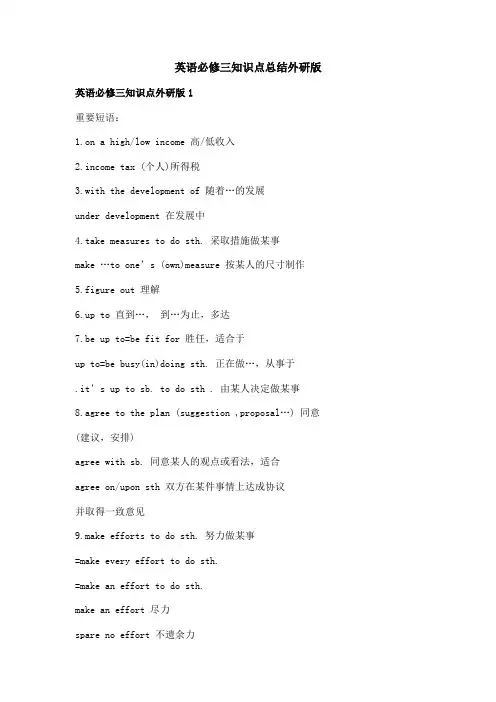
英语必修三知识点总结外研版英语必修三知识点外研版1重要短语:1.on a high/low income 高/低收入2.income tax (个人)所得税3.with the development of 随着…的发展under development 在发展中4.take measures to do sth. 采取措施做某事make …to one’s (own)measure 按某人的尺寸制作5.figure out 理解6.up to 直到…,到…为止,多达7.be up to=be fit for 胜任,适合于up to=be busy(in)doing sth. 正在做…,从事于.it’s up to sb. to do sth . 由某人决定做某事8.agree to the plan (suggestion ,proposal…) 同意(建议,安排)agree with sb. 同意某人的观点或看法,适合agree on/upon sth 双方在某件事情上达成协议并取得一致意见9.make efforts to do sth. 努力做某事=make every effort to do sth.=make an effort to do sth.make an effort 尽力spare no effort 不遗余力with/without effort 费力地/毫不费力地10.make progress 进步11.give examples of 举…的列子12.make sure 确保,查明13.figure out 理解,弄明白14.be similar to sb/sth. 与…相似be similar in 在某方面相似similarly 同样地,类似地15.share sth. among /between sb. 将某物分配给某人share sth. with sb. 与某人分享某物share (in)sth. 共享16.be/get close to 靠近,近,接近,即将发生17.as a result of 由于as a result 结果result in 导致result from 由…引起18.be of+抽象名词=be+该名词的同根形容词eg. His advice is of value to us. = valuableThis dictionary is of great use. =usefulWhat he said is of importance for you. = important 英语必修三知识点外研版2重要短语:1.The house faces to the south 这个房子朝南=The house faces towards the south。
必修三Module 1⒈be located/ situated ( on/ in / to…) = lie/ stand (on/ in/ to)位于…的;坐落于…的;处于…地位(状态的)⑴我们学校坐落于一个美丽的地方,周围有青山绿水环绕。
Our school is situated in the beautiful place, with green mountains and clear rivers around.◆ situation n. 立场;局势;形势in a …situation 处于….状况中;在…形势下1). In the present situation, I wouldn’t advise you to sell your house. 在目前的形势下,…2). You’re putting me in a very embarrassing situation. 你使我处于非常尴尬的境地。
3). With no rain for three months and food supplies running out, the situation here is getting worse.三个月无雨,食品供应也将消耗殆尽,这里情况越来越糟糕了。
⒉face1). face up to 勇敢面对(接受并处理)(be) faced with 面对;面临face (to the) south/north/east/west 面朝南/北/东/西2). face to face 面对面(地)in (the) face of 面对;在…面前make a face at 向…做鬼脸save/lose face 保全/丢面子to one’s f ace 当着某人的面stare sb. in the face 盯着某人turn red in the face 涨红了脸be+过去分词+介词(这些词作状语或定语时用ed形式,be 去掉)be faced with;be compared withbe seated;be hidden;be lost / absorbed/occupied inbe abandoned/ addicted to(沉溺于);be born;be dressed ;be tired of (厌烦)等⒊表示“某物在哪个方向”可用south/north/east/west等,构成以下几种表达方式。
(1). …is in the south of 在…的南部(在内部)…is on the south of 在…的南边(接壤)…is to the south of 在…以南(在外部)…is south of 在…的南部(不指明在内部还是外部)(2). 把表示方位、地点的介词或副词短语放在句首,句子用完全倒装语序。
①.Jiangsu is on the south of Shandong.South of Shandong is Jiangsu.②.East of our school lies a railway.⒋倍数表示法:as…as◎A is …↓… (more than) times -er than B倍数the N. ofsize, length, height, weight…⒌主谓一致⑴三原则:①语法一致的原则:语法一致的原则是指主语为单、复数与谓语动词要相呼应。
但要注意一些特殊情况;1)以along with, together with, with, as well as, accompanied by, rather than, but, except 连接的两个主语,其谓语的单复数以第一个主语为主。
例如:Several passengers, together with the driver, were hurt.2)表示时间,重量,长度,价格等的复数名词,作主语从整体来看时,谓语动词用单数。
例如:Fifty years is not a long time.3)非谓语动词,从句或其他短语作主语,谓语动词用单数形式。
例如:Early to bed and early to rise is healthful.4)如果主语是由and连接的两个单数名词,但前面有each, every, no 等词修饰时,谓语用单数。
例如:Every boy and girl in this region is taught to read and write.②意义一致的原则:意义一致的原则指谓语动词的单复数取决于主语所表达的概念,而不取决于表面的语法标志,主要表现为某些集体名词后可跟动词单数或复数。
如果这些集体名词指整体概念时,谓语动词用单数;指具体成员时用复数。
例如:The population of the earth is increasing very fast.类似这样的集体名词有:family, class, audience, committee (委员会), crowd, crew, group, party, population, team, public, council (理事会), village等。
③就近原则:所谓就近原则是指谓语动词单复数取决于离它最近的词语,而无须考虑其他的词。
1)以either…or, or, neither…nor和not only…but also连接的两个主语,其谓语的单复数形式应与离谓语最近的主语保持一致。
例如:Either you or he has to go there with me. 2)由there或here引起的主语,而又不止是一个时,采取就近原则。
例如:Here is a pen, a few envelopes and some paper for you.谓语动词用单数的情况:谓语动词用复数的情况:谓语动词用单/复数的情况:必修三Module21. till :直到up to sth be fit for :胜任be busy in doing sth :忙着做…be up to sb=be left to sb to decide :由…决定/ 负责1)I can take up to four people in my car. 我的汽车最多能做四个人2)I have never heard from her up to now. 我至今也没有她的音讯。
3)What’s he up to ? 他在忙什么?4) It’s up to you to decide where we go for a picnic.由你决定我们应去哪儿野餐。
5)李平不能胜任他的工作。
Li Ping is not up to his job.6)这个帐篷至多能睡十人。
Up to ten people can sleep in this tent.2. measuremeasure sth in/by sth用···来衡量,用···来计算take measures to do采取措施做某事1)People in Los Angels measure distance in time, not miles.翻译洛杉矶人用时间来计算(两地)距离而不是用英里数。
2)The Chinese government is taking effective measuresto develop the economy.中国政府正在采取强有力的措施来发展经济。
3. sure1) make sure表示“务必”,“确信”,“弄明白”,后面常接of/about sth.或that引导的宾语从句。
Make sure(that) you will arrive there on time. 你务必准时到这。
I know there’s a train this afternoon, but I must make sure of the time.我知道今天下午有列火车,但我必须弄清楚(发车)时间。
2)be sure of, be sure that 对···有把握,对···确定,确信Can we be sure of his honesty. /Can we be sure that he is honest? 我们能相信他是诚实的?I’m sure of winning the game. 我有把握能赢得比赛。
3) be sure to do 说话人推测主语“一定;必然会”或(常用于祈使句)务必做某事He is sure to be back soon. 他一定会很快回来。
Be sure not to forget it. 千万别忘了。
注意:be sure of 与be sure to do的区别:①.He is sure of his success. =He is sure that he will succeed. 他确信他会成功。
②.He is sure to succeed. 他一定会成功。
(说话人的看法)③.Be sure to write and tell me all your news. 务必来信把你所有情况都告诉我。
另外,常见的与sure相关的短语还有:be sure of oneself 有自信心,for sure的确;确实地,sure enough果真,果然。
用于口语,此时的“Sure.”相当于“Of course.” 与“Certainly.”。
4. From the agreement came the Human Development Report.表示方位或方式的副词和介词短语放在句首用完全倒装, 即谓语动词完全置于主语之前。
At the foot of the mountain lies a small village. 在山脚下有一个小村庄。
Out rushed the children. 孩子们冲了出去。
Here comes the bus. 车来了。
(To the) south of our school stand many shops.【部分倒装】①only修饰副词、介词短语或状语从句,放于句首②否定副词never, nor, not, hardly, little, seldom等放于句首③ so+adj/adv+(倒装)+ that1. Only when he returned did we find out the truth (We found out the truth only when he returned.)2. Never before have I seen such a moving film.(I have never seen such a moving film before)3. So clearly does he speak English that he can always make himself understood.(He speaks English so clearly that~)5. figure n./v.1).He had always looked upon Sarah as a kind of mother figure. 形象2).How does she manage to keep her figure when she eats so much? 体形3).He was the outstanding political figure of his time. 人物v.4).I figured that he wa s drunk and shouldn’t be allowed to drive. 认为5).It took me hours to figure those problems out. 分析;想出6).Women. I just can’t figure them out. 理解7).Many economists have been figuring out what makes China develop so fast. 分析8).指望figure on6.S.+ be + adj. + to doeasy/ good/ safe/comfortable/ dangerous/hard/ difficult…1).The water is not pure to drink (drink)2).He needs a chair comfortable to sit on.(sit )3).The young man felt the room cold to live in (live)必修三Module 31.occur 过去式occurred 过去分词occurred1)发生,出现Earthquakes occur frequently in this area.2) sth occur to sb某人想到,某事浮现脑海It never occurred to me that he might be in trouble.A brilliant idea occurred to me.【回忆“发生”】①.A big earthquake occurred /happened in the south of China last month.②.It occurred to me that she didn’t know I had moved into the new house.③.I happened to see him on my way home. = It happened that I saw him on my way home.④. A fire broke out in the hospital in the mid-night.⑤. After the flood, diseases broke out here and there.⑥.Great changes have taken place in our hometown during the past ten years.⒉strike 打击,撞击,(雷电,暴风雨等)袭击,过去式struck 过去分词struck / strickenThe clock struck five. 敲打A powerful earthquake struck the island early this morning. 袭击I was struck by its beauty. 被…打动At this point, it suddenly struck me that I was wasting my time. 浮现; 使人想起【注意区分】strike, hit, beat, knockstrike “(钟)敲打,撞击,袭击”,表示有力的打一下。